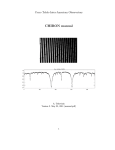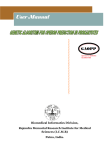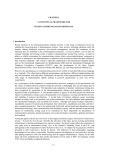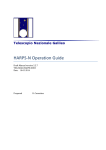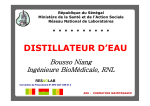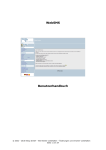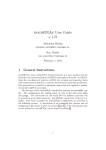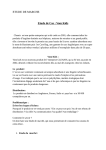Download PDF, 183K
Transcript
CHIRON Exposure Meter
Version 2
Author: Andrew Szymkowiak (Yale University)
Last update: July 27, 2015
File: prj/bme/chiron/EM/EMv2.doc
1
1
Short description and hardware
The main functions of the Chiron Exposure Meter (from now on, "expm" for short) is to calculate the photon-weighted
mean time for exposures, and to stop the exposures so that a targeted level of signal is collected. Its hardware consists of
three main components - a Hamamatsu PMT which views a small amount of the light after the spectrograph collimator,
through a pick-off mirror and a fiber, an electronics box which takes the drive signal for the shutter and outputs logic
signals to the parallel port of the third component, a PC running Linux.
Figure 1. Block-diagram of EM hardware and connections.
Figure 1 shows main components of the EM and their connections. The PMT is Hamamatsu H9319-01. It is housed in a
light-tight metal box, with a green filter (Chroma D545/80x) in front of it. The fiber is “scotched” into the box (no
connector). The device is powered by 5V. Digitized counts are read by the computer, which also turns the high voltage
(HV) ON or OFF. There is no built-in over-light protection, the PMT will be damaged if exposed to ambient light with HV
ON! The EM software switches HV OFF if the detected flux exceeds a certain threshold.
Figure 2. Block-diagram of the PMT circuits (left) and the transmission of the filter (right).
This documentation consists of five sections: an overview of the system, a users guide, a more detailed description of the
2
processing, details of the software, including descriptions of the interfaces between expm components and those to the rest
of the Chiron system, and an estimate of the sensitivity of the system (and an appendix with miscellaneous details not yet
woven into the text).
2. Overview
The drive signal for the Chiron shutter goes true for the duration of the exposure - the "shutter logic box" makes a positive
going pulse at both edges of the shutter signal in order to trigger the parallel port, and also passes the signal to another
input line of the parallel port so that the program can sense the polarity of the transition. The Linux system has a custom
version for the parallel port driver, which records the system clock in the interrupt routine that is triggered by the shutter
edge pulses. The software consists of the main handler ("expmsrv") which reads from the expm hardware, and a
number of client programs which connect to a socket server in expmsrv to get access to the data.
The Hamamatsu PMT digitizes the light level and outputs a stream of counts to the serial port of the Linux box, with 0.1s
cadence. The main program contains a tight loop which uses a non-blocking read to look for the current sample from the
PMT; when the read returns a sample the program assigns the current system time to that sample. Since there can be some
latency in this time assignment, the times assigned to the serial samples are likely not as accurate as those assigned to the
shutter edges.
The expmsrv program must be installed to run as root, since it must directly attach to the parallel and serial ports. When
the program is started, it initializes the PMT, including turning on the high voltage (HV), and starts looking at the
incoming samples. If a programmable number of samples consecutively exceeds a threshold, the HV will be tripped off to
protect the PMT. The expmsrv program opens three files, with timestamp names (in the form yyyymmddhhmmss). The
arriving samples are binned and are continuously written to the ".cnts" file. Information about each exposure is written to
the ".log" file. In addition, copies of the information that is sent for populating the FITS headers is written to the ".fitinf"
file. When expmsrv detects a shutter open, it records the opening time, and begins accumulating the information needed to
calculate the photon-weighted mean time. When the shutter close is detected, the calculations are performed, the
information is written to the log, and the info needed for the FITS headers are written to the appropriate output.
The expmsrv looks for client programs to connect to a particular socket. Upon connecting, each client sends an integer to
indicate which one of several types of connections it wishes to make. These mostly have the sense of being an output
stream for expmsrv data.
There are two main clients which should probably always be running, in normal production use of Chiron. The first is the
"FITS client" – it requests the stream of FITS values. As expmsrv calculates the exposure values, and writes them to the
log file and the fitinf file, it also outputs them to all clients that asked for the FITS stream. This client takes the stream, and
sends it to Chiron database system, which is interrogated during the writing of the FITS header. If the exposure meter has
populated the database, the values will appear (if the system is down, the FITS header values will be zeroes).
The second "production" client is called the "early termination client". It listens on a socket for target count values, and
receives a stream of integrated counts from the expmsrv. If it has been sent a target count, it will calculate for the current
increase in counts when the target will be reached, and send the Chiron control system a request to terminate the exposure
at the appropriate time.
3. User guide
The expmsrv computer is named "expmeter60". We are working on some cron jobs which will kill and start expmsrv, and
the FITS and early term clients at noon every day. We'll also place here the name of scripts to kill and restart the three
main programs. (If there are problems, do a "ps aux|grep exp|more" and look for the process ids for processes whose
names start "expmsrv", "expfits", and "expterm", and "kill -SIGINT" those processes (SIGINT rather than KILL because
the expmsrv can detect the interrupt and shutdown the HV cleanly.))
One of the other utility clients is the status GUI; the name starts with "expst". This GUI has an indicator at the top for the
HV status, three lines for status messages, and three buttons. The indicator can show as blue for "unknown" (only just
after status client has been started), red for HV off, and green for HV on. The "update" button will ping the expmsrv main
3
and update the indicator. The HV ON and HV OFF buttons are self-explanatory. (The button labelled "rebase" is not
operational (yet).) The main purpose for this GUI is to detect whether the safety check has tripped off the PMT HV, and
to provide manual control of the HV (for instance if the system is going to be worked on). (Possibly these functions should
just be added into the Chiron control GUI, rather than requiring this separate client to be running).
Another utility client can plot the light curve from the PMT. Its name starts with "expplt", and it has 4 input boxes to set
the limits of the plot and a button to choose to plot the log of the intensities. This display is currently mainly for debug
use, as it replots all the points upon the arrival of each new sample, and cannot keep up with a small bin size or many
points in the plot. (We hope to write a better plot client some day).
(A description of the photon weighted mean time calculations and FITS variable contents might be placed here; in the
interim, an examination of the source code will probably serve to provide details of these calculations and interfaces.)
4. Software details
Both the main and some of the clients look for an environment variable named EXPMPFDIR which tells them where to
find the parameter files for setting various things. (When this was written, the env var is set at login time to point to
/home/expmeter/EXPPFFILES. The .cshrc also sets two other environment variables; LD_LIBRARY_PATH which is
loaded with a library that the clients need, and EXPMHOST which tells the clients where to look for the expmsrv main.)
The pf (parameter file) for the expmsrv is named "expm.pf"; here is the current contents:
[expmeter@expmeter ~/EXPPFFILES]$ more expm.pf
2000 //port_num
10 //num_pmt_samples /* must correspond to value on P cmd sent to PMT */
20 //binning_size
0 //ser_time_offset
10 //avg_size
10000000 //threshold
10 //thresh_cntr_max
The first one ("port num") is the port on which expmsrv will start listening for connections from clients. The second
("num_pmt_samples") is probably not being used at the moment (this should be remedied in a future software revision).
The PMT intrinsically samples at 10 ms intervals, and a command sent at startup has it do some binning. Having this set
to 10 means the program is receiving binned samples every 0.1 seconds. The third ("binning_size") is the additional
binning used for the samples logged to the .cnts file, and sent to the plot client. 20 corresponds to 2 second bins. The
fourth ("ser_time_offset") could be used to remove a skew from the serial sample time assignments. Currently I do not
know what value this should have, and leave it at zero. The fifth ("avg_size" is how many bins are combined to form the
averages used to estimate the pre- and post-exposure backgrounds. The sixth ("threshold") and seventh
("thresh_cntr_max") are used for tripping off the HV - in this example, 10 consecutive samples exceeding 10 million
counts will shut the HV off.
Here is the contents of the expfits4.pf file:
[expmeter@expmeter ~/EXPPFFILES]$ more expfits4.pf
ctioe1.ctio.noao.edu
5415
These items are merely the address and port number of where to make the socket connection for sending the database
commands to set the values of the FITS header values. This program also reads files named add_keys and del_keys from
the current directory (not yet the pf directory - this should probably be fixed). Here are their current contents:
[expmeter@expmeter ~/EXPFITS4]$ more add_keys
dbs set _queue_ em_timopn 0 STR
dbs set _queue_ em_timcls 0 STR
dbs set _queue_ em_numsmp 0 I32
4
dbs set _queue_ em_avg 0.0 FLOAT
dbs set _queue_ em_avgsq 0.0 FLOAT
dbs set _queue_ em_prdsum 0.0 FLOAT
dbs set _queue_ em_netint 0.0 FLOAT
dbs set _queue_ em_mnwob 0 STR
dbs set _queue_ em_mnwb 0 STR
fits key add emtimopn 'dbs em_timopn' //shutter open time from exposure meter __
AFTER__ __IFNDEF__ 0000-00-00T00:00:00.000
fits key add emtimcls 'dbs em_timcls' //shutter close time from exposure meter _
_AFTER__ __IFNDEF__ 0000-00-00T00:00:00.000
fits key add emnumsmp 'dbs em_numsmp' //number of samples __AFTER__ __IFNDEF__ 0
fits key add emavg 'dbs em_avg' //average intensity __AFTER__ __IFNDEF__ 0.0
fits key add emavgsq 'dbs em_avgsq' //sum of squared intens __AFTER__ __IFNDEF__
0.0
fits key add emprdsum 'dbs em_prdsum' //sum of products of intens and bin number
__AFTER__ __IFNDEF__ 0.0
fits key add emnetint 'dbs em_netint' //net intensity after bckgrd subtraction _
_AFTER__ __IFNDEF__ 0.0
fits key add emmnwob 'dbs em_mnwob' //mean time without bckgrd subtraction __AFT
ER__ __IFNDEF__ 0000-00-00T00:00:00.000
fits key add emmnwb 'dbs em_mnwb' //mean time with bckgrd subtraction __AFTER__
__IFNDEF__ 0000-00-00T00:00:00.000
dbs flush em_timopn
dbs flush em_timcls
dbs flush em_numsmp
dbs flush em_avg
dbs flush em_avgsq
dbs flush em_prdsum
dbs flush em_netint
dbs flush em_mnwob
dbs flush em_mnwb
The contents of the add_keys file is sent to the database server when the program is started, to prepare the system to deal
with the FITS variables when they are set.
[expmeter@expmeter ~/EXPFITS4]$ more del_keys
dbs delete em_timopn
dbs delete em_timcls
dbs delete em_numsmp
dbs delete em_avg
dbs delete em_avgsq
dbs delete em_prdsum
dbs delete em_netint
dbs delete em_mnwob
dbs delete em_mnwb
fits key delete emtimopn
fits key delete emtimcls
fits key delete emnumsmp
fits key delete emavg
fits key delete emavgsq
fits key delete emprdsum
fits key delete emnetint
fits key delete emmnwob
fits key delete emmnwb
The del_keys file is (supposed to be) sent when the program exits cleanly, in order to cleanly remove the expmeter
5
variables from the FITS headers. (Currently the program apparently does not ever exit cleanly, so that the expmeter items
stay in the headers, but with zero values). If desired, the del_keys file could be streamed into the database socket by hand
if you want those items to not appear in the headers.
Here is the current contents of the pf file for the early termination client:
[expmeter@expmeter ~/EXPPFFILES]$ more exptermb1.pf
2110
ctioe1.ctio.noao.edu
5415
10
100
10
1000
The first parameter is the port number on which the client will listen for threshold setting commands. The second and
third rows set the server and port number where the system will send the "set exposure time" commands to terminate the
exposure. The fourth row sets a variable named "binsize"; this must correspond to the sampling being done in the PMT,
and is used to know how to use the slope in sample number to predict an exposure time in seconds. The fifth row sets a
variable named "rotbuf_size", (which is the dimensions of a internal rotating buffer) which is used to record the most
recent samples in order to estimate the slope. The sixth row sets a variable named "delta_cnts"; this is the minimum
number of counts that will be used to estimate a slope - for a bright source it may use the most recent two samples, but for
a dimmer source it will go back through the buffer until it can find when the accumulated intensity was at least delta_cnts
lower (this is in order to have a good SNR for the slope estimations). The seventh row set a variable named
"emit_predict_time", which is how much in advance of the predicted threshold crossing time to start emitting exposure
time updates.
5. Software interface details
(still to be written - needs at least three parts:
(1) description of how to connect to the expmsrv port, and of the various types of data streams
(2) description of commands sent to the expterm client
(3) descriptions of expst commands (update, hv_on, hv_off) and of the returned status messages)
Also needs a description of format of the .cnts file (and of the .fitinf file?)
Until this is written, reading the source code will be the best way to find these details)
Computer requirements:
The current generation of the h/w requires a Linux computer with a serial and parallel port. The parallel port interface was
chosen as an inexpensive way to get an interrupt tied to an external logic signal (and with a second input available to
detect current shutter signal level status). As this legacy interface is vanishing from modern motherboards, we might want
to consider other options; for instance, just obtaining the shutter transition times from the Torrent. (Another option would
be to get two GPIO inputs some other way; there are inexpensive PCI cards, and embedded Linux system boards
(Raspberry Pi; BeagleBone Black) w/ GPIO pins (though would need CMOS instead of TTL levels).
The custom parallel port driver is a modification of the “ppdev” driver supplied with the 2.6.32 Linux kernel. We have
used Scientific Linux 6 and a CentOS distribution – both of these systems are redistributed versions of the Red Hat
Enterprise Linux 6 system. The ppdev interrupt routine was modified to place the state of the shutter level signal and the
time into a ring buffer when the interrupt is triggered by the signals generated at the shutter signal edges. A new ioctl
(PPGETINTTIME) was added to the driver to be used in the main to fetch entries from the ring buffer. This modified
driver is in the directory rpmbuild/BUILD/kernel-2.6.32-431.el6/linux-2.6.32-431.el6.i686/drivers/char/ppdev in the
expmeter user’s home directory. A new kernel (and modules) is created by doing a “make; make install; make
modules_install” series of commands. The /boot/grub/grub.conf file is then modified to point to the new kernel.
6
Exposure meeting sensitivity:
(probably just a copy of Julien's memo with the calcs, or a pointer to that memo and info from power meter measurements
during the re-commisioning.)
Miscellaneous facts not yet woven into text:
Another part of the hardware is a 5 volt power supply for the Hamamatsu PMT. The 5 volts is connected through a 4 pin
circular Tyco connector. The positive voltage lead first passes through a loop (blue wire) on the PMT side of the
connector before being sent to the PMT - this was to allow for the future installation of a safety switch, for instance on the
Chiron lid, to shut off the PMT power when opening the spectrometer,
The shutter logic box has three connections; a three pin Lemo connector that receives a copy of the Chiron shutter signal
(third wire is for power for an optical isolator), a DB-25 connector that delivers the signals to the parallel port, and a USB
connector, which is just used to deliver 5 volt power to the circuitry inside the box. (Insert circuit diagram and PCB board
layouts here).
This document does not cover the EM optics inside CHIRON that directs part of the light into EM fiber. See Section 3.7
and Figure 14 in the Instrument Description document,
http://www.ctio.noao.edu/noao/sites/default/files/telescopes/smarts/tele15/chiron_0.pdf
7
6. Notes on Exposure Meter, CHIRON software side
The Chiron software connects to the Exposure Meter as yet another client. It generates two connections, one is for sending
commands to the expm (threshold, request/set for HV value) and another to receive PM data, used mainly to Real time
graph for the observer
On the other hand, the exposure meter software connects to the torrent acquisition software (panview), to set the keywords
that will be written to the fits header images. The keywords are the ones explained section 4 of this document.
The figure below shows the general architecture, and the Chiron Plug-In that graphs the PM data. For a complete
documentation (and details) on this please refer to document CHI60S-2.6 (Chiron software description) and CHI60S-1.3
(Chiron software User Manual).
8








